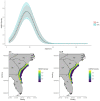Abundance estimation for line transect sampling: A comparison of distance sampling and spatial capture-recapture models
- PMID: 34048456
- PMCID: PMC8162584
- DOI: 10.1371/journal.pone.0252231
Abundance estimation for line transect sampling: A comparison of distance sampling and spatial capture-recapture models
Abstract
Accurate and precise abundance estimation is vital for informed wildlife conservation and management decision-making. Line transect surveys are a common sampling approach for abundance estimation. Distance sampling is often used to estimate abundance from line transect survey data; however, search encounter spatial capture-recapture can also be used when individuals in the population of interest are identifiable. The search encounter spatial capture-recapture model has rarely been applied, and its performance has not been compared to that of distance sampling. We analyzed simulated datasets to compare the performance of distance sampling and spatial capture-recapture abundance estimators. Additionally, we estimated the abundance of North Atlantic right whales in the southeastern United States with two formulations of each model and compared the estimates. Spatial capture-recapture abundance estimates had lower root mean squared error than distance sampling estimates. Spatial capture-recapture 95% credible intervals for abundance had nominal coverage, i.e., contained the simulating value for abundance in 95% of simulations, whereas distance sampling credible intervals had below nominal coverage. Moreover, North Atlantic right whale abundance estimates from distance sampling models were more sensitive to model specification compared to spatial capture-recapture estimates. When estimating abundance from line transect data, researchers should consider using search encounter spatial capture-recapture when individuals in the population of interest are identifiable, when line transects are surveyed over multiple occasions, when there is imperfect detection of individuals located on the line transect, and when it is safe to assume the population of interest is closed demographically. When line transects are surveyed over multiple occasions, researchers should be aware that individual space use may induce spatial autocorrelation in counts across transects. This is not accounted for in common distance sampling estimators and leads to overly precise abundance estimates.
Conflict of interest statement
The authors have declared that no competing interests exist.
Figures


Similar articles
-
An open spatial capture-recapture model for estimating density, movement, and population dynamics from line-transect surveys.Ecol Evol. 2021 May 3;11(12):7354-7365. doi: 10.1002/ece3.7566. eCollection 2021 Jun. Ecol Evol. 2021. PMID: 34188818 Free PMC article.
-
Integrating population dynamics models and distance sampling data: a spatial hierarchical state-space approach.Ecology. 2016 Jul;97(7):1735-1745. doi: 10.1890/15-1406.1. Ecology. 2016. PMID: 27859153
-
State-space mark-recapture estimates reveal a recent decline in abundance of North Atlantic right whales.Ecol Evol. 2017 Sep 18;7(21):8730-8741. doi: 10.1002/ece3.3406. eCollection 2017 Nov. Ecol Evol. 2017. PMID: 29152173 Free PMC article.
-
Estimating animal population density using passive acoustics.Biol Rev Camb Philos Soc. 2013 May;88(2):287-309. doi: 10.1111/brv.12001. Epub 2012 Nov 29. Biol Rev Camb Philos Soc. 2013. PMID: 23190144 Free PMC article. Review.
-
A review of spatial capture-recapture: Ecological insights, limitations, and prospects.Ecol Evol. 2021 Dec 21;12(1):e8468. doi: 10.1002/ece3.8468. eCollection 2022 Jan. Ecol Evol. 2021. PMID: 35127014 Free PMC article. Review.
Cited by
-
Animal reactivity to camera traps and its effects on abundance estimate using distance sampling in the Taï National Park, Côte d'Ivoire.PeerJ. 2022 May 27;10:e13510. doi: 10.7717/peerj.13510. eCollection 2022. PeerJ. 2022. PMID: 35651744 Free PMC article.
References
-
- Borchers DL, Marques TA. From distance sampling to spatial capture-recapture. AStA Adv. Stat. Anal. 2017;101: 475–494.
-
- Calambokidis J, Barlow J. Abundance of blue and humpback whales in the eastern North Pacific estimated by capture-recapture and line-transect methods. Publications, Agencies and Staff of the U.S. Department of Commerce; 2004. 10.1897/03-85 - DOI
-
- Minton G, Peter C, Poh ANZ, Ngeian J, Braulik G, Hammond PS, et al. Population estimates and distribution patterns of Irrawaddy dolphins (Orcaella brevirostris) and Indo-Pacific finless porpoises (Neophocaena phocaenoides) in the Kuching Bay, Sarawak. Raffles B. Zool. 2013;6: 877–888.
-
- Noss AJ, Gardner B, Maffei L, Cuéllar E, Montaño, Romero-Muñoz A, et al. Comparison of density estimation methods for mammal populations with camera traps in the Kaa-lya del Gran Chaco landscape. Anim. Conserv. 2012;15: 527–535.
Publication types
MeSH terms
LinkOut - more resources
Full Text Sources
Other Literature Sources

